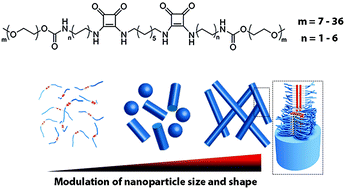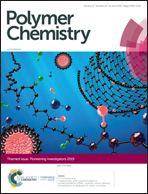Shape modulation of squaramide-based supramolecular polymer nanoparticles†
Abstract
We report the synthesis and self-assembly of a library of squaramide-based bolaamphiphiles with variable hydrophobic and hydrophilic domain sizes, consisting of varied aliphatic chains (n = 2 to 12 methylene repeat units) and linear oligo(ethylene glycol) (m = 11 to 36 repeat units), to understand their effect on the formation of supramolecular polymer nanoparticles. Systematic variation of the hydrophobic chain length show that a minimum hydrophobic domain is required to shield the squaramide units from water when a constant hydrophilic domain is maintained for self-assembly. By contrast, significant increases to the hydrophilic chain length of the bolaamphiphile, while keeping the hydrophobic domain constant, results in a transition from fibrillar to spherical nanoscale objects with an alteration in the aggregation mode of the monomers likely due to steric constraints of the oligo(ethylene glycol) chains. By understanding the self-assembly space achievable for these squaramide-based bolaamphiphiles through examining the interplay between various monomer features, we show their distinct effects on the formation of self-assembled nanoparticles with possibilities to modulate their shape and size in water for future applications in the biomedical area.

- This article is part of the themed collection: Pioneering Investigators


 Please wait while we load your content...
Please wait while we load your content...